Despite the efficacy and benefits of Cloud-native development, the Mainframe remains a core and valuable enterprise technology for large enterprise customers (especially in Finance, Insurance, Manufacturing, Retail, and Public sector). Maybe because Mainframe offers resiliency, reliability, and trusted security. But it isn’t enough to sustain in today’s disruptive business environment.
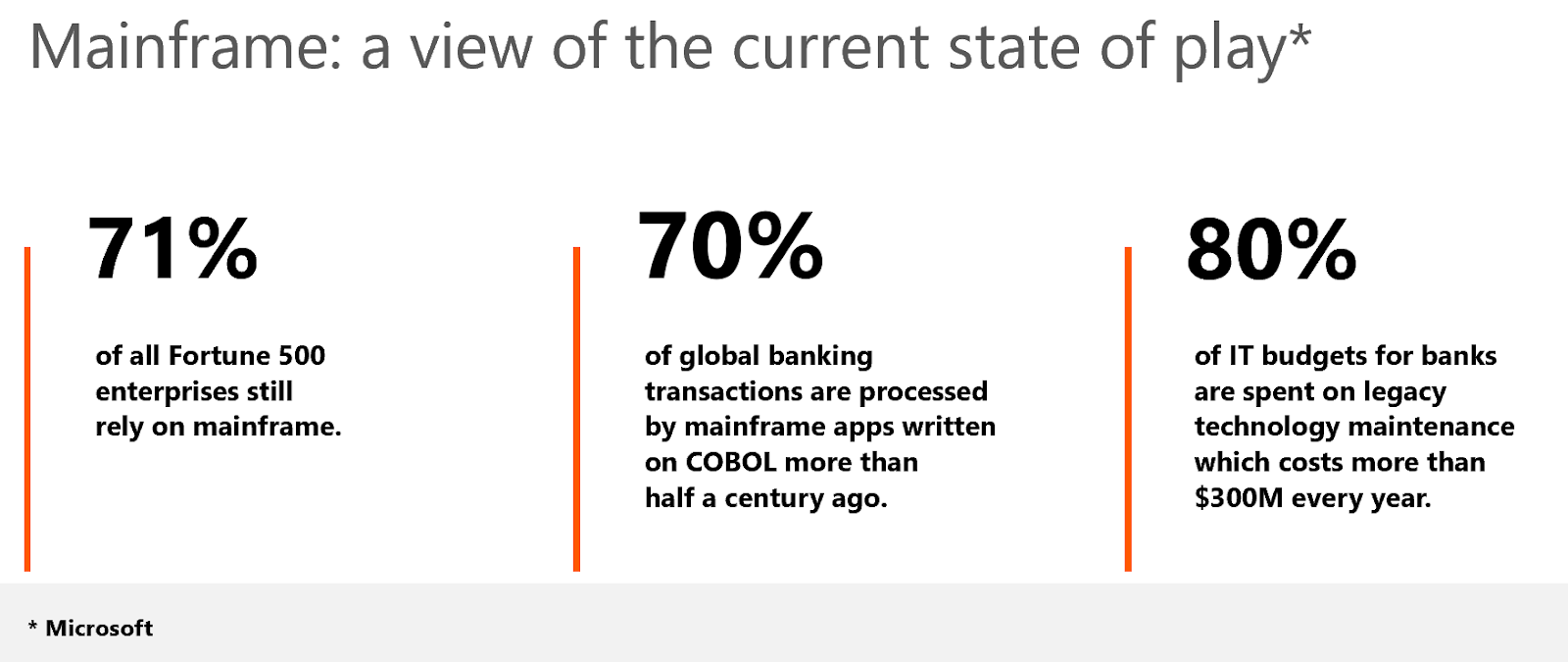

Faster time to Market, Employee, and Customer experience has become a business imperative, and the Mainframe systems are a significant barrier in achieving the same. The flexibility and versatility of Cloud DevOps are overshadowing the Mainframe’s ability to innovate in the current business environment. Cost considerations and changes in the workforce also impact Mainframe’s viability as a long-term technology solution.
Moreover, the Covid-19 pandemic has highlighted the need for Mainframe modernization:
- Skills / Talent availability, remote management, and access for handling and running the Mainframe System
- Scalability and flexibility required for unprecedented demands (user and transaction volumes)
- Remote Monitoring and Management for System support
Public Cloud platforms like Microsoft Azure offer Mainframe alternatives capable of delivering equivalent functionality and features, thus eliminating the problems and costs incurred from utilizing a legacy Mainframe system.
Read through this article to know more about the challenges and benefits of Mainframe Modernization to cloud and understand the correct Mainframe Modernization approach to kickstart your migration journey.
What Is Mainframe Modernization?
Mainframe Modernization entails the process of migrating or improving the IT operations to reduce IT spending efficiently.
In the realm of improving, we can define<strong> Mainframe Modernization as the process of enhancing legacy infrastructure by incorporating modern interfaces, code modernization, and performance modernization. In terms of migration, it is the process of shifting the enterprise’s code and functionality to a newer platform technology like cloud systems</strong>. The strategy employed to modernize Mainframe structures relies on factors like business/customer objectives, IT budgets, and costs of running new technology vs. costs incurred from not modernizing.
Challenges Of Mainframe Systems
Mainframe disadvantages result in high costs that are increasingly difficult to justify. Common challenges that business faces with Mainframe Legacy systems are:
- The shrinking talent pool of mainframe expertise: According to a Forrester study commissioned by Compuware, 23% of the Mainframe workforce has been lost, and 63% have not been replaced. The average age of COBOL and Mainframe experts is 50+ years, and the hardcore mainframe architecture and engineering skills are becoming rarer in the market. Experienced staff is exiting the workforce, sometimes leaving behind little documentation and with unclear succession plans. This can leave mainframe environments vulnerable to a shrinking skills base and a material loss of knowledge about how these legacy systems work. The new generation of IT developers and experts are focused and proficient in modern/ cloud platforms and tools. This certainly highlights that modern IT experts are unwilling to learn an old programming language to sustain legacy infrastructures.
- High costs for hardware/storage: Mainframes systems are costly as compared to the modern “scale-out,” on-demand, pay-as-go computing model offered by Public Cloud providers.
- Outdated programming language: Computing languages used by most Mainframes (COBOL, Fortran, PL/I, Natural) are considered obsolete. This makes finding or building innovative solutions for the Mainframe difficult.
- Tightly coupled integrations: Tightly coupled and complex mainframe architectures with interdependencies make the solution difficult to maintain
- Resistance to change
- Lack of documentation: Most of the enterprises today are struggling with lack of documentation (and sometimes not even having original source code) for mainframe systems
- Challenges with business continuity and DR deployment for Mainframe Systems
- Platform issues and Inflexibility
- Lack of Business Agility offered by Mainframe System (e.g., need for Faster Time to Market, New regulatory compliance, new SLA, new business models, and integration with new core business systems developed outside Mainframes) – resulting in the inability to keep up with the digital disruption.
- Limited Test environments
- Lack of Test Automation and DevOps processes
Due to the challenges mentioned above, most customers are stuck with Mainframes’ legacy, with Technology Debt increasing every year.
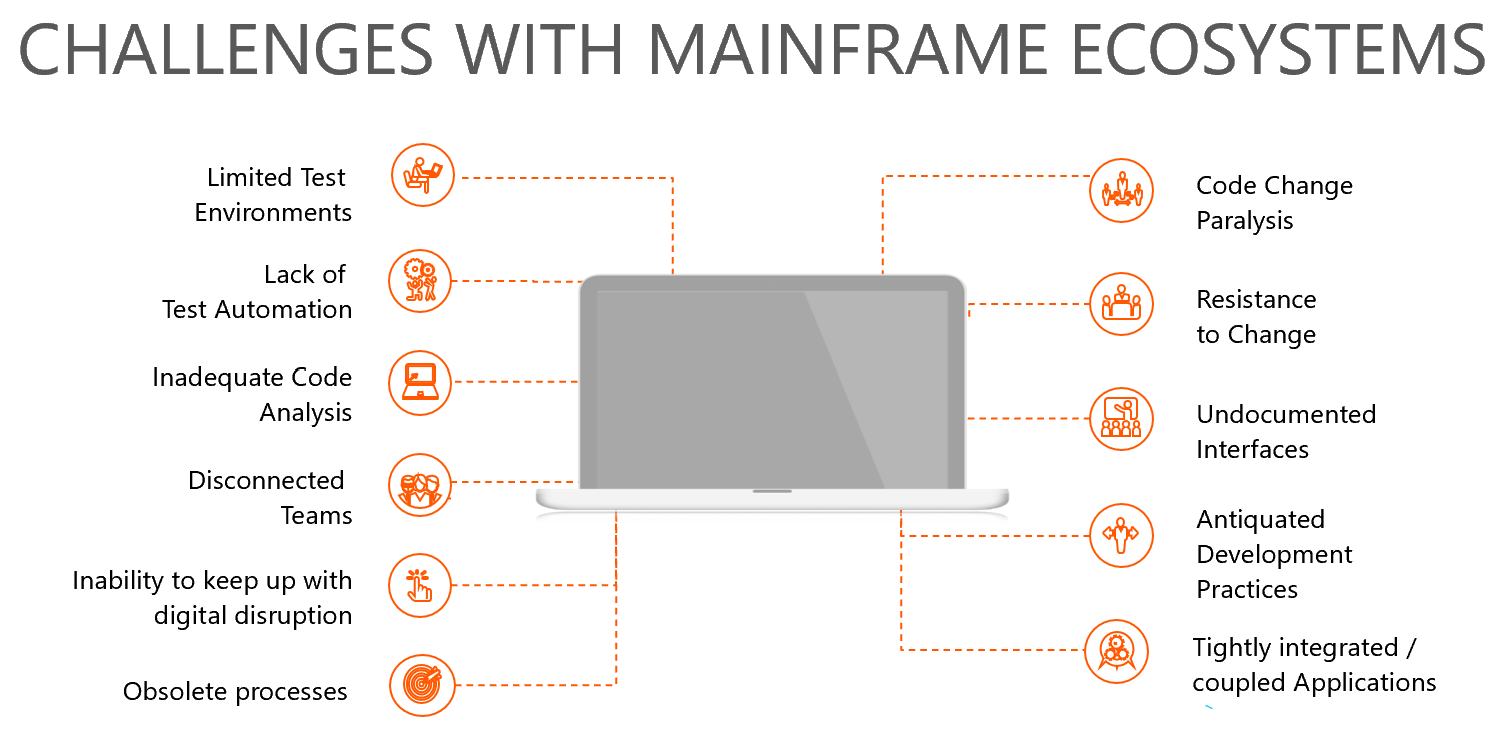
While mainframe modernization delivers significant benefits, it can have far-reaching consequences that affect your technology and workforce, customer experience, and other related activities.
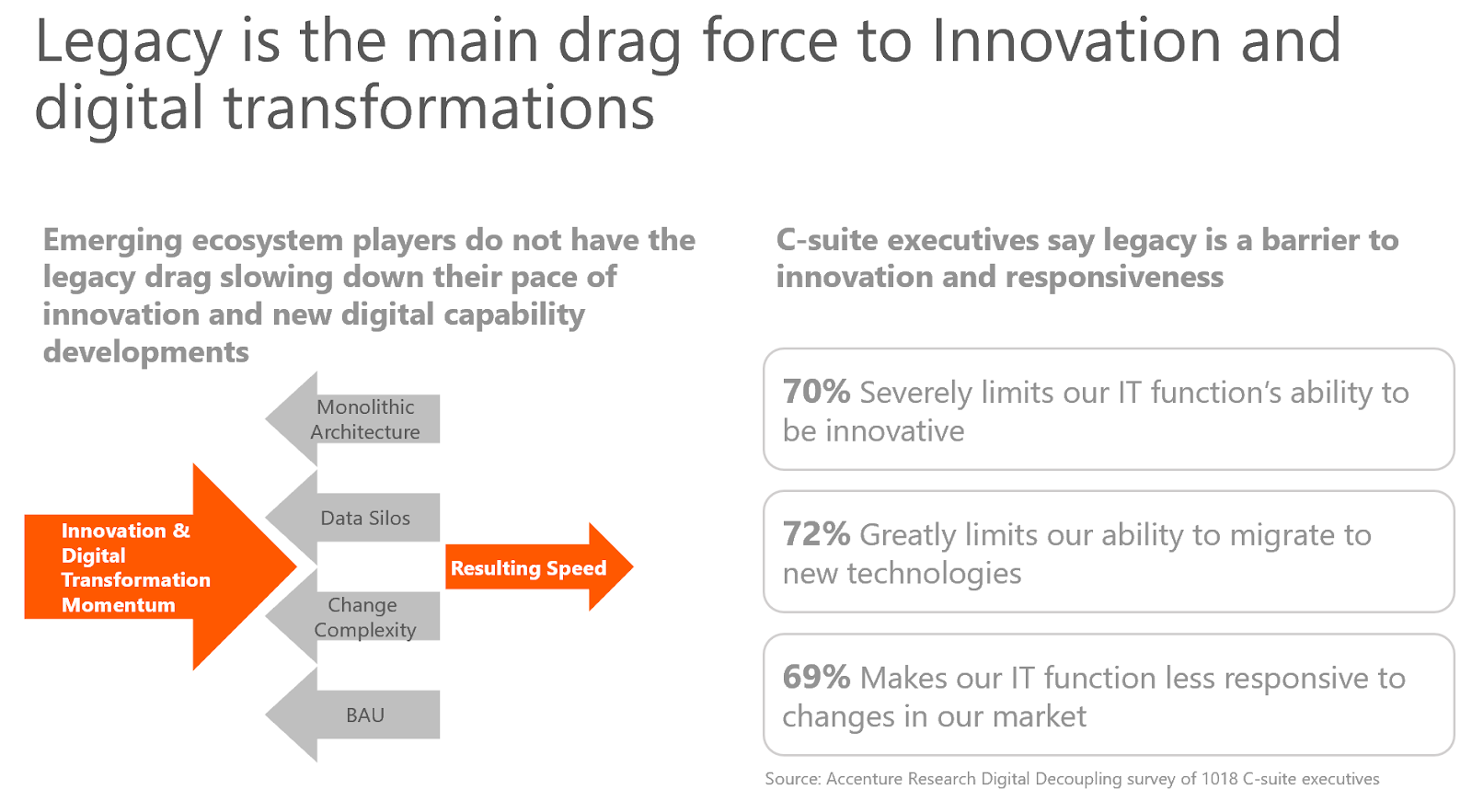

Benefits Of Mainframe Modernization To Cloud
Cloud can offer economies of scale and new functions that are not available through mainframe computing. The benefits of cloud technologies and the law of diminishing returns in the Mainframe are calling for an increased demand for migration strategies. By taking a thoughtful, phased approach to modernizing your mainframe environment, you can overcome common obstacles and enjoy some of the advantages of cloud computing without putting core functionality at risk.
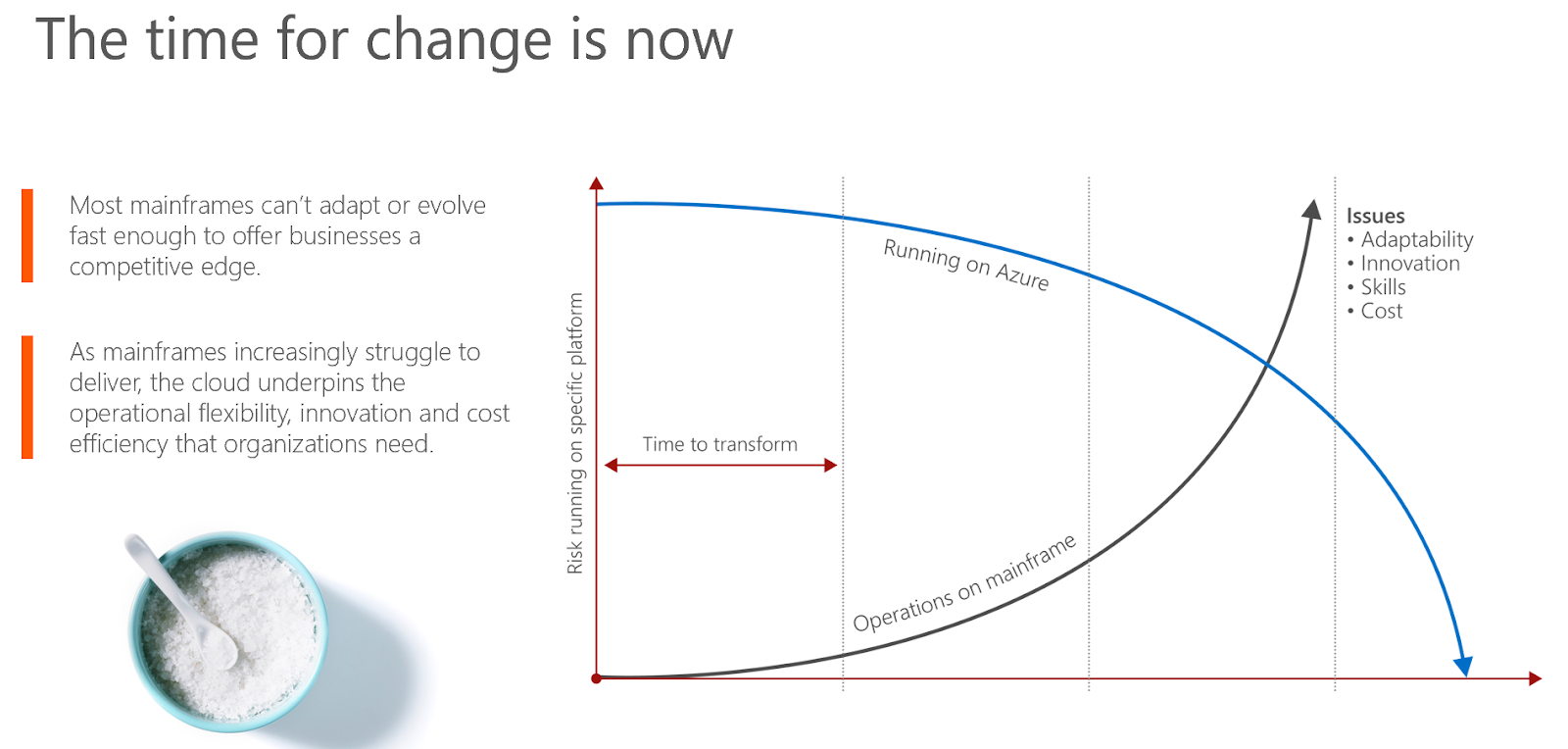
- Reduced cost: With modernization, you can reduce the cost of MIPS (Millions of Instructions per Second), the cost of spending on hardware and support personnel (who are becoming more and more thanks to advanced technologies). As mentioned earlier, the more the overload on Mainframe structures, the more the incurred costs.
- Faster Time to Market
- Unlock your Data: Data is the new currency for business and key for future growth. Businesses can unlock their data’s true potential (Data as an asset for Data-Driven Decision Making) with Cloud scale Datawarehouse, AI, and ML models. Convert for
- Support for System on Innovation and experimentation required to sustain business in digital age disrupted by unicorns and startups with new business models and alternative products/services.
- Business Agility: By modernizing your Mainframe environment by migrating to the cloud, you can reap the benefits and capabilities of this new system that ensures increased agility, scalability, and cost-efficiency.
- Adaptability and Faster Integration: With new application development happening worldwide, it is imperative to integrate modern technologies to sustain businesses. It is considered that 85% view application development as the driving force of business growth. Embracing new technologies like IoT, Virtual Reality, etc., requires cloud infrastructures that offer platforms to implement these.
- Competitive Edge: Commencing your modernization journey affords you a competitive edge that puts you ahead in the market.
- Modern Skills and Productivity: Instead of halting your businesses and operations by suffering from skills risk or maintaining legacy systems, you can fully exploit the capabilities of cloud computing systems that offer you enhanced security and the means to work remotely.
- Better Employee and Customer Experience
- Near Realtime Business Continuity and DR
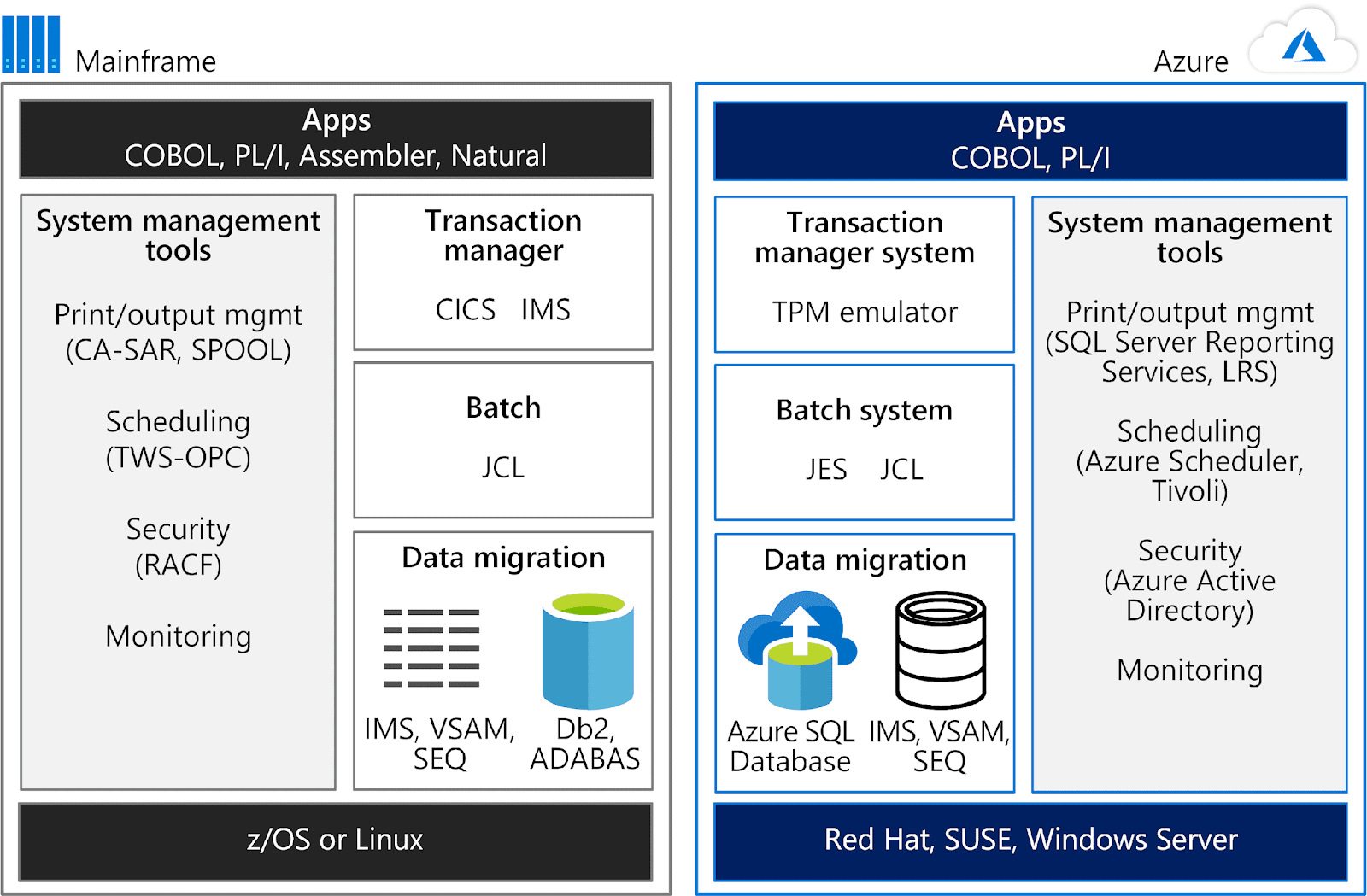
Considerations of Mainframe Modernization to Cloud Business Case Evaluation
The prerequisites in strategizing for Mainframe Modernization to Cloud or a co-existence journey should be based on a holistic and strategic view. According to a study published by Accenture, enterprises’ primary motivation to move to the cloud is the cost-efficiency benefit. Hence, to truly reap the benefits of cost-efficiency, businesses must consider the following steps laid down by the study to assess their mainframe-to-cloud cost business case:
- The opportunity cost of not modernizing (or missing out on delivering new features to customers)
- Analyze current mainframe costs: An enterprise shouldn’t necessarily consider the recharge costs here but should consider real mainframe spending, which includes hardware, software, DC space, electricity, and workforce supporting the Mainframe Systems.
- Define target state architecture: A business should define its desired architecture and mainframe modernization approach. They can genuinely assess and calculate the run costs such as – solution components, software, cloud providers, and internal headcount.
- Add transformation costs: Transformation costs should include – assessment, migration/modernization services cost, other third-party tools used in migration/modernization, tools required in the target state, internal changes (For example, costs incurred from management changes from transitioning to a new system), change management cost, any 3rd party costs for compliance and audit for the target architecture and managed services cost for the new solution.
- Evaluate the results from steps 1- 4 to understand the effectiveness of your migration. Assess the TCO and ROI of modernizing to a new cloud system.
7R Approach For Mainframe Modernization
It’s clear that Organizations should at least take steps to modernize their mainframe environment to meet current market conditions and customer expectations. The question is, how to do it and what might be getting in the way?
This approach should consist of a planned strategy wherein you analyze all your applications and chalk out a systemic application strategy. This approach should be navigated using the 7R approach to ease your modernization process:
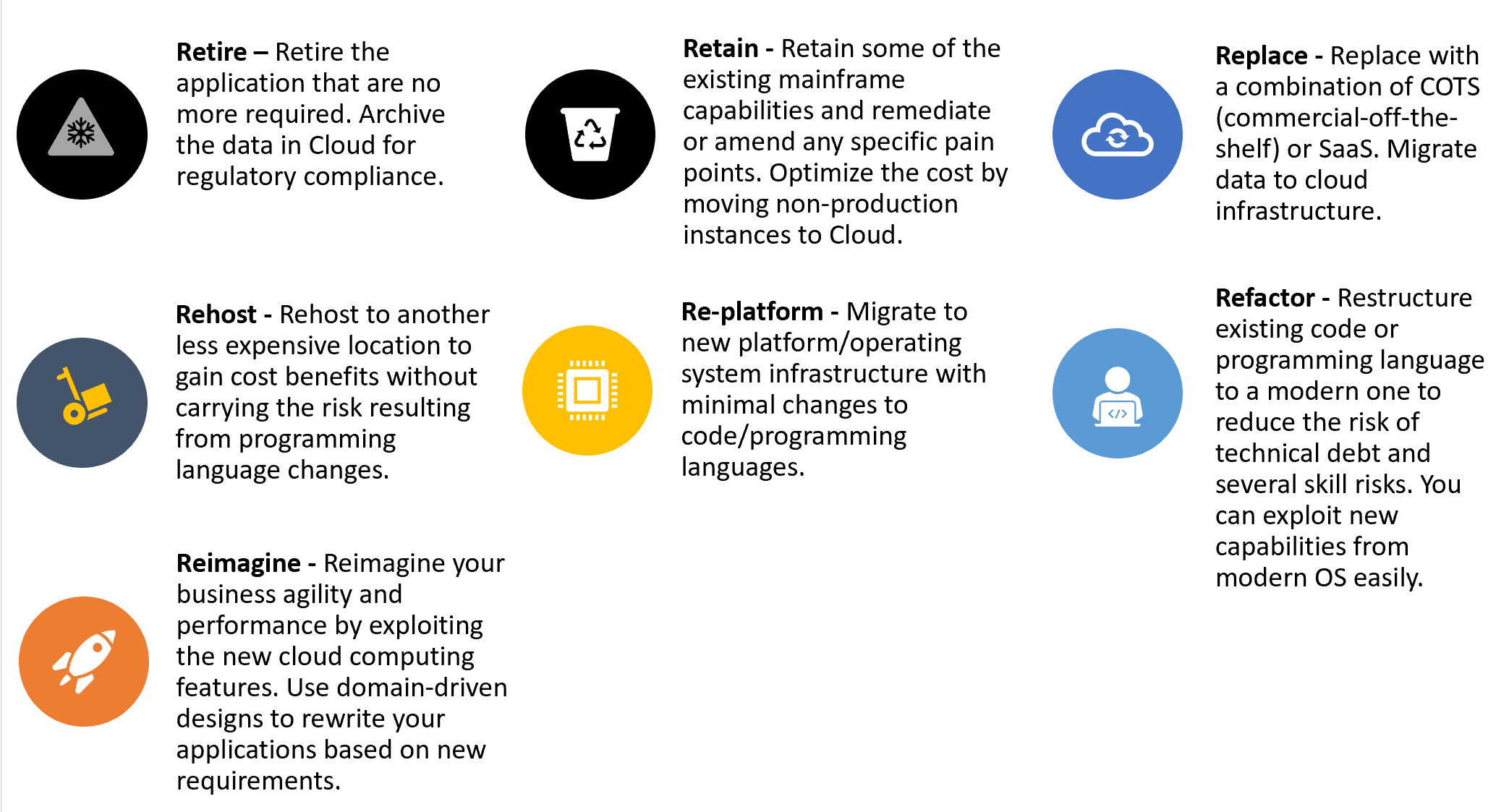
- Retire – Retire the application that is no more required. Archive the data in Cloud for regulatory compliance.
- Retain – Retain some of the existing mainframe capabilities and remediate or amend any specific pain points.
- Replace – Replace with a combination of COTS (commercial-off-the-shelf) or SaaS. Migrate data to cloud infrastructure.
- Rehost – Rehost to another less expensive location to gain cost benefits without carrying the risk resulting from programming language changes.
- Re-platform – Migrate to new platform/operating system infrastructure with minimal changes to code/programming languages.
- Refactor – Restructure existing code or programming language to a modern one to reduce the risk of technical debt and several skill risks. You can exploit new capabilities from modern operating systems easily.
- Reimagine – Reimagine your business agility and performance by exploiting the new cloud computing features. Use domain-driven designs to rewrite your applications based on new requirements. This lets you not establish your application on current needs, allowing you to modernize your technology and obsolete business processes.
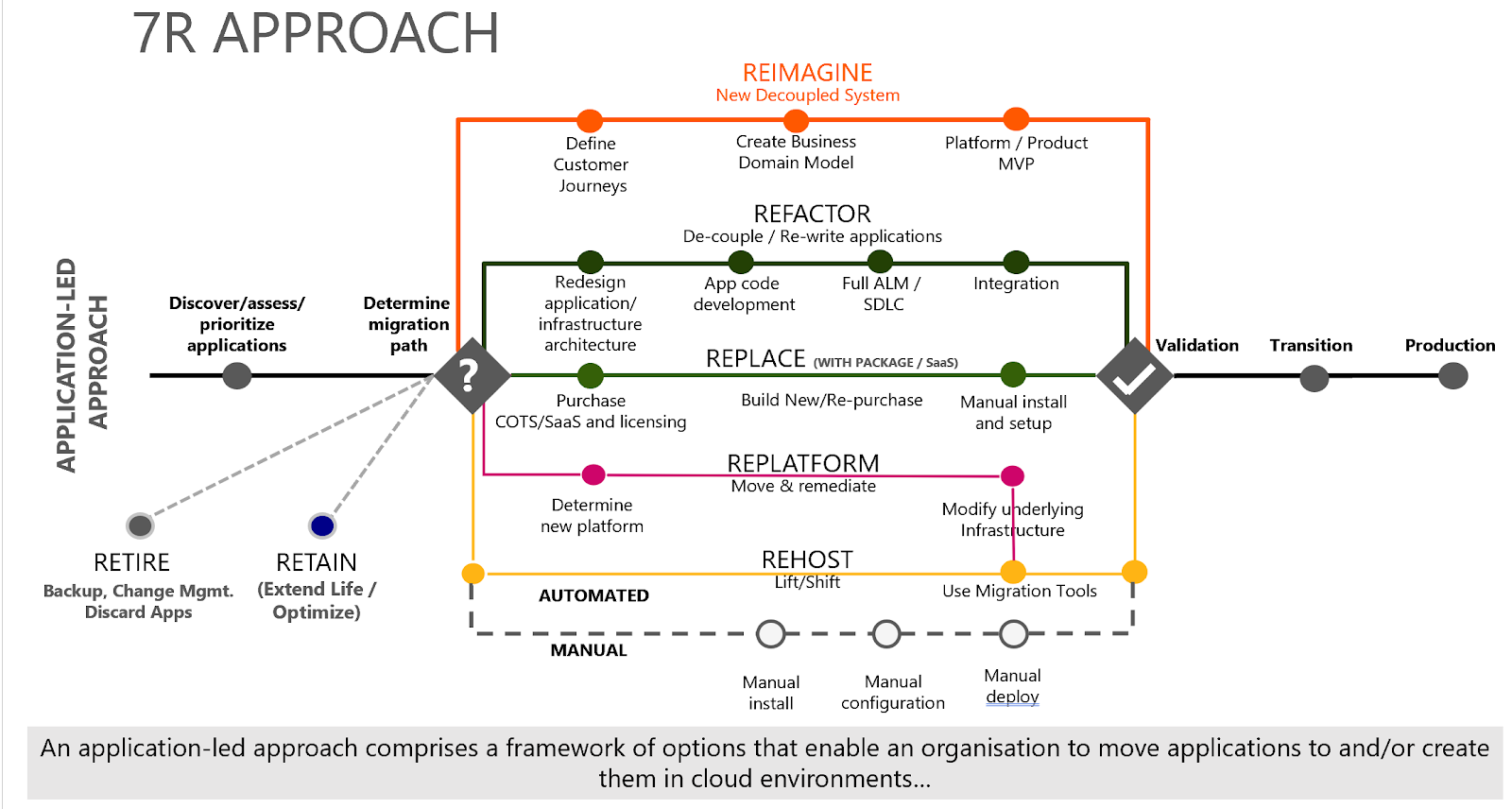
To be successful with Mainframe Modernization, Enterprise needs to avoid risky “big bang” conversions and migrations.
Each Mainframe application might require a different application disposition (a separate path on 7R).
For large monolithic apps, sometimes a journey might be a mix of 2-3 disposition paths (for example: Refactor the Database, Rehost / Replatform the UI, and Decouple the business logic).
During the Modernization journey, pay additional attention to address the following aspects:
- Begin with use cases that increase business value through improved agility and flexibility. Your efforts should gain credibility based on smaller, successful initiatives.
- Perception of no need for near real-time Business Continuity and DR
- There is zero room for error. Any outage during migration could have devastating consequences in terms of disrupting mission-critical operations
- Perception of Mainframe is Secure
- Resistance to change: In a recent survey, 56% of the respondents reported their organizations resisted legacy systems’ modernization. This stems from being very comfortable in their existing systems. Also, owing to specific mission-critical applications being much more difficult to modernize, they choose to leave them in their legacy systems because of their interdependencies and complexities.
- Risk-averse nature of Business stakeholders
- Going against the proven functionality and the “It works” effect of Mainframe- Mainframes have proven functionality. Businesses that use Mainframes are in a “comfort zone” owing to their “It works” attitude. This attitude of “They’ve always been there, and they’ve always worked” can essentially make businesses complacent.
- Executive sponsor beyond IT and availability of Funds
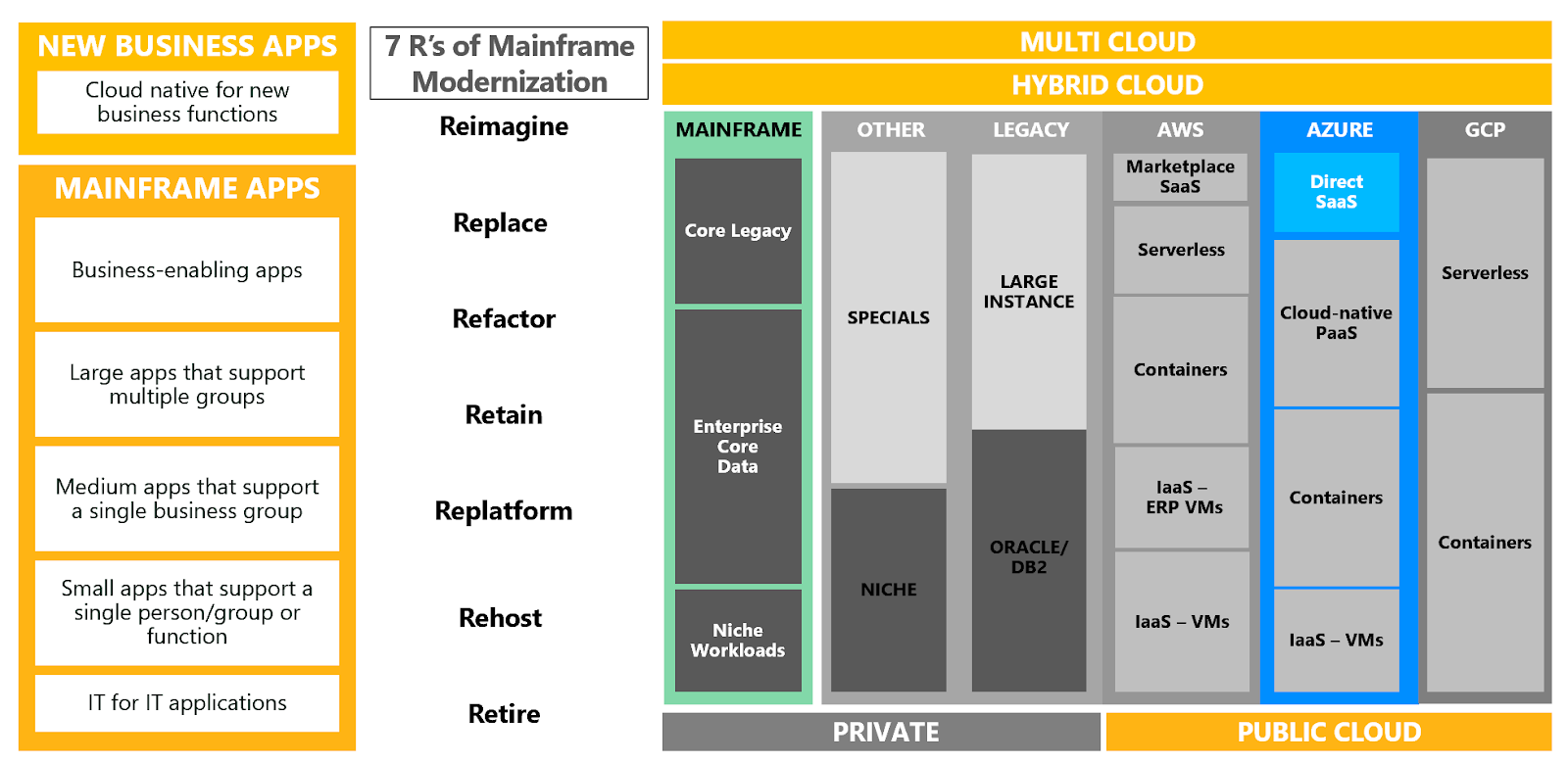
Typical Mainframe Migration / Modernization process
The process for migration/modernization should entail these steps:
- Discover
- Access & Plan
- Proof of Architecture
- Migrate / Modernize
- Test
- Change Management
- Go Live and Transition

During the Migration / Modernization process, please ensure:
- Avoid big-bang approach
- Perform detailed Analysis and Assessment
- Map the migration/modernization approach with the right partner with deep expertise on Mainframe Systems, target Cloud Platform, and healthy relationship with Mainframe Modernization ecosystem partners like Raincode, ModernSystems, LzLabs,MicroFocus,BluAge, TMaxSoft, etc.
- Identify the right use case to gain critical momentum and credibility by identifying use cases that improve agility and flexibility.
Summary
To summarize, there is no ‘one-size-fits-all’ strategy when it comes to Mainframe Modernization. Each business case is unique, and they must consider a well-thought and thorough approach to modernizing their legacy Mainframe systems.
While many large and well-tenured enterprises are still using Mainframe, it becomes essential to note that modernizing remains a business-critical strategic imperative in today’s technological environment. It helps them keep abreast with the ever-changing customer expectations and attain a more agile and straightforward architectural framework.
Public Cloud, as noted, is the way to modernize your legacy Mainframe environment as cloud computing offers 70% cost saving, agility, resilience to accelerate Digital Transformation. Yes, there is no magical ‘lift-and-shift’ approach or a silver bullet to modernize your Mainframe systems or applications. But it can be done by employing and leveraging a well-planned and researched cloud migration strategy. I say the time to modernize is NOW and that the cloud benefits should warrant a re-think for companies that are still on the fence.




